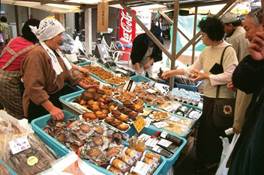Use and Conservation
Morning markets and produce standsIt is said that morning markets and produce stands began when people gathered to exchange produce. In Wajima City on shrine festival days, an exchange market is held, which is said to have been the start of the Wajima morning market, and has a more than one thousand year history. In addition, it is thought that the cities scattered around the region functioned as centers of distribution and information. The morning market began as a place where the bounties of the mountains and sea came together – a place to exchange things for other things, in addition to being a place to exchange a range of information such as new vegetables, efficient fishing methods, cultivation methods for pest-resistant rice and cooking & food preservation methods. At the morning markets where face-to-face sales are the norm, a range of information is exchanged along with the sales even today. Buyers, whether visitors or local consumers, gain a deeper understanding of Noto’s Satoyama and Satoumi systems just by asking about the characteristics of the produce or cooking methods, food culture or details about the production area. Since the sellers are in direct contact with the consumers’ reactions, they can become aware of the differences with other regions or receive objective feedback about the Satoyama and Satoumi of Noto where they themselves live. Furthermore, profits gained from market sales also have the role of supporting the economic activities of the Satoyama and Satoumi which have been maintained and protected by human effort. Even if produce/products or sales styles change with the times, morning markets and produce stands remain extremely important places for the exchange of products and information and as a place to simply convey to many people the diverse resources that are deeply rooted in the region.
Green Tourism, Eco TourismGreen Tourism and Eco Tourism are the names given for trips where people visit rural, mountain or fishing villages, and enjoy getting close to nature, culture, industries and people. Green tourism is experience-based tourism in which urban dwellers leave their daily lives for agricultural and fishing villages to experience and get close to farm work and fisheries, traditional foods of the region and the knowledge or techniques used to process them, and activities in mountains and rivers. This style of tourism is often included as part of a school trip or an after-school course. Eco tourism is a style of tourism in which local resources are utilized with careful management so as to limit the effect on the natural environment and living things. There are several reasons for the popularity of these types of tourism in recent years, including the needs of the urban dwellers to recover from their busy lives in the city by getting in touch with nature or for the emotional education of children, as well as the needs of the local communities for community revitalization or economic revival through welcoming the tourists to their communities. Behind all this is also the change in values of people who have come to realize the importance of living together with nature and re-acknowledging the value of the old way of life.
Noto has all the right conditions for green tourism and eco tourism, with its proximity to the sea and mountains and its abundance of daily food culture and lifestyle aspects as well as local religious festivals. In addition, there are many new initiatives which are attempting to make continued and wise use of satoyama and satoumi local resources – which were not previously thought to be sources of tourism.
The support of new workers and new settlersThe biggest issues for Noto are population decline and the aging population. In particular, the lack of new workers and those who can be responsible for the agriculture, forestry and fishing industries will lead to an increase in derelict agricultural land, and since it will also have a big effect on the native habitats of living creatures, it is a big problem in terms of the preservation of biodiversity. Furthermore, there are also districts and areas that are struggling with the maintenance and continuation of traditional events, folk culture and customs of the settlements due to a lack of people power. However it will be very difficult for the residents of the local communities to find a quick solution to the problems of depopulation and aging of the population by themselves.
|
 |
     Loading
|






















